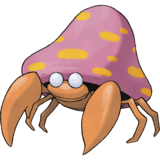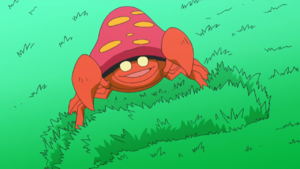From Bulbapedia, the community-driven Pokémon encyclopedia.
|
|
| Line 371: |
Line 371: |
| * Parasect is one of the few Pokémon not in the [[List of Pokémon by Sinnoh Pokédex number|Sinnoh Pokédex]] that has different [[Pokédex]] entries in {{2v2|Diamond|Pearl}}. | | * Parasect is one of the few Pokémon not in the [[List of Pokémon by Sinnoh Pokédex number|Sinnoh Pokédex]] that has different [[Pokédex]] entries in {{2v2|Diamond|Pearl}}. |
| * Parasect and its pre-evolved form, {{p|Paras}}, share their species name with {{p|Shroomish}}, {{p|Breloom}}, {{p|Foongus}}, {{p|Amoonguss}}. They are all known as Mushroom Pokémon. | | * Parasect and its pre-evolved form, {{p|Paras}}, share their species name with {{p|Shroomish}}, {{p|Breloom}}, {{p|Foongus}}, {{p|Amoonguss}}. They are all known as Mushroom Pokémon. |
| | ** These are also the only Pokémon that can have the ability {{a|Effect Spore}} without having come from the {{pkmn|Dream World}}. |
|
| |
|
| ===Origin=== | | ===Origin=== |
Revision as of 01:52, 24 July 2011
|
|
|
|
|
|
|
|
|
|
|
|
|
|
|
Height
3'03"
Imperial
|
1.0 m
Metric
|
3'03"/1.0 m
Red-Striped
|
0'0"/0.0 m
Blue-Striped
|
0'0"/0.0 m
|
|
|
Weight
65.0 lbs.
Imperial
|
29.5 kg
Metric
|
65.0 lbs./29.5 kg
Red-Striped
|
0.0 lbs./0.0 kg
Blue-Striped
|
0.0 lbs./0.0 kg
|
|
|
|
|
|
|
|
|
|
|
|
|
EV yield
HP
0
|
Atk
2
|
Def
1
|
Sp.Atk
0
|
Sp.Def
0
|
Speed
0
|
| Base Exp.: 128
|
Battle Exp.: 1281*
|
|
|
|
|
Parasect (Japanese: パラセクト Parasect) is a dual-type Bug/Grass Pokémon.
It evolves from Paras starting at level 24.
Biology
Physiology
Like its previous stage, Parasect is an insectoid creature. However, in this stage, the mushroom has completely overtaken the host's body. The insect has been drained of nutrients and is now under the control of the fully grown tochukaso.
Due to the influence of the tochukaso in its growth, the insect's metamorphosis has been stunted and it instead resembles a grotesque, exaggerated version of its former self. Its pincers and legs have grown much larger and the mushrooms on its back have grown together into one giant mushroom. Its eyes have become whited out resembling those of zombies, likely due to its being possessed by the tochukaso.
These mushrooms that grow on Parasect are often prized by collectors.
Gender differences
None.
Special abilities
The mushroom completely takes over its host's body. Parasect now has more control over it. It still releases irritating spores that can paralyze, poison, or put to sleep.
Behavior
Although appearing to be docile, they are actually quite dangerous and will attempt to attack anything that invades their territory. They can use many moves which involve slashing, such as Slash, Cross Poison, and X-Scissor, which makes them quite deadly.
Habitat
Parasect can often be found in caves, since sunlight and dry air hurt their skin. They can also thrive in dank forests with a suitable amount of humidity, where conditions are ideal for fungi. It is most common in Kanto, but can be found almost anywhere Paras can be found.
Diet
- Main article: Pokémon food
In the anime
Major appearances
Parasect first featured in The Problem with Paras under the ownership of Cassandra as a very weak Paras. Cassandra needed it to evolve into a Parasect so she can use the giant mushroom to aid in her medical research. After it battled with Ash's Pokémon (albeit, all of them except his disobedient Charmeleon not trying at all), and a battle with Team Rocket, Paras evolved.
Minor appearances
In Hocus Pokémon, Lily needed Stun Spore from a Parasect to complete a spell.
Officer Jenny uses a Parasect in Gulpin it Down.
Pokédex entries
| Episode
|
Pokémon
|
Source
|
Entry
|
| EP044
|
Parasect
|
Ash's Pokédex
|
Parasect, the Mushroom Pokémon. It battles using poison spears that spread from the mushroom canopy on its back.
|
|
In the manga
In the Pokémon Adventures manga
In Pokémon Adventures, Crystal uses a Parasect extensively in her Pokémon capturing, using its Spore attack to put targets to sleep. In Volume 10, her Parasect is seen to be capable of increasing the radius of its Spore attack to at least 3 km. In Volume 11, the origin of Crystal's Parasect is revealed: it, along with Crystal's Natu, Hitmonchan, and Cubone, were wild Pokémon living in Mt. Mortar and had fought with a local Arcanine that had gone berserk from a severe eye injury. Parasect was able to create medicinal spores to help Arcanine heal and Crystal recover from her fractured arms. In Volume 13, Crystal reveals yet another ability of Parasect: it is able to use the powder attacks it possesses to combine into a wider range of spores, including one for corroding metals.
In the TCG
- Main article: Parasect (TCG)
Game data
Pokédex entries
| This Pokémon was unavailable prior to Generation I.
|
| Generation I
|
|
| Red
|
A host-parasite pair in which the parasite mushroom has taken over the host bug. Prefers damp places.
|
| Blue
|
| Yellow
|
The bug host is drained of energy by the mushrooms on its back. They appear to do all the thinking.
|
| Stadium
|
The bug host is controlled by the mushrooms that scatter poisonous spores. The spores are sometimes used as medicine in China.
|
|
|
| Generation II
|
|
| Gold
|
It stays mostly in dark, damp places, the preference not of the bug, but of the big mushrooms on its back.
|
| Silver
|
The larger the mushroom on its back grows, the stronger the mushroom spores it scatters.
|
| Crystal
|
When nothing's left to extract from the bug, the mushrooms on its back leave spores on the bug's egg.
|
| Stadium 2
|
It stays mostly in dark, damp places, the preference not of the bug, but of the big mushrooms on its back.
|
|
|
| Generation III
|
|
| Ruby
|
Parasect is known to infest large trees en masse and drain nutrients from the lower trunk and roots. When an infested tree dies, they move onto another tree all at once.
|
| Sapphire
|
{{{sapphiredex}}}
|
| Emerald
|
Parasect are known to infest the roots of large trees en masse and drain nutrients. When an infested tree dies, they move onto another tree all at once.
|
| FireRed
|
It scatters toxic spores from the mushroom cap. In China, the spores are used as herbal medicine.
|
| LeafGreen
|
A host-parasite pair in which the parasite mushroom has taken over the host bug. Prefers damp places.
|
|
|
| Generation IV
|
|
| Diamond
|
A mushroom grown larger than the host's body controls Parasect. It scatters poisonous spores.
|
| Pearl
|
It is controlled by a mushroom grown larger than the bug body. It is said to prefer damp places.
|
| Platinum
|
A mushroom grown larger than the host's body controls Parasect. It scatters poisonous spores.
|
| HeartGold
|
It stays mostly in dark, damp places, the preference not of the bug, but of the big mushrooms on its back.
|
| SoulSilver
|
The larger the mushroom on its back grows, the stronger the mushroom spores it scatters.
|
|
|
| Generation V
|
|
| Black
|
A mushroom grown larger than the host's body controls Parasect. It scatters poisonous spores.
|
| White
|
{{{whitedex}}}
|
| Black 2
|
{{{black2dex}}}
|
| White 2
|
{{{white2dex}}}
|
|
|
|
|
Game locations
| This Pokémon was unavailable prior to Generation I.
|
|
|
|
|
|
|
|
|
|
|
|
|
In side games
Held items
Stats
Base stats
| Stat
|
Range
|
| At Lv. 50
|
At Lv. 100
|
60
|
|
120 - 167
|
230 - 324
|
95
|
|
90 - 161
|
175 - 317
|
80
|
|
76 - 145
|
148 - 284
|
60
|
|
58 - 123
|
112 - 240
|
80
|
|
76 - 145
|
148 - 284
|
30
|
|
31 - 90
|
58 - 174
|
Total: 405
|
Other Pokémon with this total
|
- Minimum stats are calculated with 0 EVs, IVs of 0, and (if applicable) a hindering nature.
- Maximum stats are calculated with 252 EVs, IVs of 31, and (if applicable) a helpful nature.
- This Pokémon's Special base stat in Generation I was 80.
|
Pokéathlon stats
Type effectiveness
| Under normal battle conditions in Generation V, this Pokémon is:
|
|
|
|
|
|
|
|
|
|
|
|
|
Learnset
|
|
|
|
- Bold indicates a move that gets STAB when used by Parasect
- Italic indicates a move that gets STAB only when used by an Evolution of Parasect
- Click on the generation numbers at the top to see level-up moves from other generations
|
|
|
| Game |
Move |
Type |
Cat. |
Pwr. |
Acc. |
PP
|
| This Pokémon learns no moves by tutoring.
|
- A black abbreviation in a colored box indicates that Parasect can be tutored the move in that game
- A colored abbreviation in a white box indicates that Parasect cannot be tutored the move in that game
- Bold indicates a move that gets STAB when used by Parasect
- Italic indicates a move that gets STAB only when used by an Evolution of Parasect
- Click on the generation numbers at the top to see Move Tutor moves from other generations
|
|
|
| Stage |
Move |
Type |
Cat. |
Pwr. |
Acc. |
PP
|
| This Pokémon has no moves exclusive to prior Evolutions.
|
- Bold indicates a move that gets STAB when used by Parasect
- Italic indicates a move that gets STAB only when used by an Evolution of Parasect
- Click on the generation numbers at the top to see moves from other generations
|
Side game data
Evolution
Sprites
Trivia
- Parasect's Pokédex entry for Pokémon Stadium connects the Pokémon world with the real world, noting that its spores are sometimes used as medicine in China.
- Parasect and Paras are the only Pokémon in the game to take more than 4 times as much damage from any one type of attack under normal battle conditions (if they have the ability Dry Skin, they both take 5× damage from Template:Type2 attacks).
- In Generation I, Poison-type attacks are super effective against Bug-type Pokémon, making Parasect and Paras the only Pokémon to have ever had three 4× weaknesses, as well as a 4× weakness to Poison.
- No other Pokémon has the same egg group combination as Parasect and its pre-evolution.
- Parasect is one of the few Pokémon not in the Sinnoh Pokédex that has different Pokédex entries in Diamond and Pearl.
- Parasect and its pre-evolved form, Paras, share their species name with Shroomish, Breloom, Foongus, Amoonguss. They are all known as Mushroom Pokémon.
Origin
Bulbanews has an article related to this subject:
There are many forms of fungus that grow on insects, any one of which could have inspired Parasect's design, like the entomophthora muscae, which grows on the back of the common housefly. Its base insect is a distorted version of what is probably a cicada nymph, the parasetic fungi having caused a form of neoteny.
Name origin
Parasect's name could be a combination of "parasite" and "insect", referring to the parasitic mushroom on this insect's back. Alternatively, it could be a combination of "parasite" and "sect", which is the Latin word for cut.
In other languages
Notes
External links

|
This Pokémon article is part of Project Pokédex, a Bulbapedia project that aims to write comprehensive articles on each Pokémon species, as well as Pokémon groups and forms.
|


















































































































































